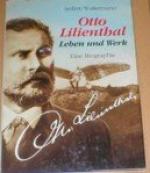|
This section contains 310 words (approx. 2 pages at 300 words per page) |
World of Invention on Otto Lilienthal
Otto Lilienthal was a major figure in the ten years preceding powered flight. His experiments with gliders were followed by the press and aviation enthusiasts all over the world. His exploits inspired many, including Orville and Wilbur Wright.
As a young man, Lilienthal loved the idea of flying. He and his brother studied birds, particularly storks, and built strap-on wings in the hopes of flying, but failed in their attempts. Even as a soldier in the Franco-Prussian War, he focused on flying.
As an adult, he studied the principles of flight. He soon realized a curved wing was the way to succeed. He measured the amount of lift that various rigid wings produced. He published findings in a book that became the bible for other aviation enthusiasts: Bird-flight As the Basis of Aviation (1889). He had tables showing calculations of lift provided by these wings, and it was this set of tables that was so admired and followed by others.
He then began experimenting with gliding as a way to prepare for powered flight. He started with short jumps, but he soon needed longer and higher areas to work. In 1894, he built an artificial hill where he achieved glides of 150 feet (45.75 m) or more. He also found hills outside Berlin where he reached a distance of 1,150 feet (350.75 m) by gliding. Lilienthal, however, probably would never have achieved successful powered flight. He maintained the only way to move through the air was by flapping wings. He devoted his energies to building machines with such flapping action, but they were so ineffective he never got to try them out.
In August of 1896, in-flight tragedy struck Lilienthal. A sudden gust of wind caused his glider to rise up swiftly. He threw his weight forward to correct the problem, but the glider stalled and crashed to the ground. He died the next day.
|
This section contains 310 words (approx. 2 pages at 300 words per page) |


